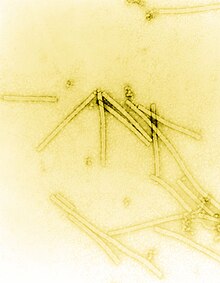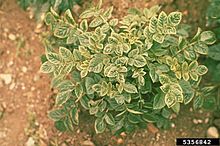植物病毒
植物病毒(Plant virus)泛指感染植物的病毒,大多為正單鏈RNA病毒[1],一般不具有外膜(布尼亞病毒目與單股反鏈病毒目的病毒則有)[2],有許多外觀呈棒狀[3],也有呈正多面體者,其中雙生病毒科的病毒由雙生的兩個正二十面體組成。植物病毒在自然界中大多以動物媒介、花粉或種子傳播,較少如動物病毒般以直接接觸傳染,動物媒介包括昆蟲、線蟲與蜘蛛等,其中以昆蟲居多(特別是半翅目昆蟲),有些病毒可進入昆蟲的血腔中,使其終生具備散播病毒的能力,有些病毒並可影響宿主花朵的特性以吸引或阻止昆蟲前來[4]。植物可以植物激素(水楊酸、茉莉酸與脫落酸等[5])啟動抗病毒反應,並以RNA干擾等機制清除病毒RNA[6],而病毒也有許多機制對抗宿主免疫反應,例如形成膜結構以避免被宿主核酸酶切割[1],並可利用植物透過胞間連絲在細胞間傳遞mRNA的機制傳播自己的RNA[7]。






許多糧食作物與經濟作物可被植物病毒感染[8],如玉米褪綠斑駁病毒、大麥黃矮病毒、小麥線條花葉病毒、水稻東格魯病毒、馬鈴薯Y病毒、甘薯褪綠矮化病毒(sweet potato chlorotic stunt virus)、番茄褐色皺果病毒、胡瓜綠斑嵌紋病毒等,可能影響糧食安全[9],估計每年在全世界造成超過600億美元的經濟損失[10],不過許多植物病毒的感染並不造成任何症狀,甚至可與植物互利共生,例如圓葉煙草被許多病毒感染後可提升對缺水逆境的抗性;有些植物還可將病毒的基因用作其他功能,如白三葉草潛隱病毒(clover cryptic virus)的衣殼蛋白被一些植物用於抑制根瘤的形成[11]。
歷史上第一種被發現的病毒煙草花葉病毒(TMV)即為植物病毒[12]。有些植物病毒在科學研究或農業上具有應用價值,在生物學研究中,有些植物病毒可被研究人員用作載體將遺傳物質送入植物細胞中[13];有些園藝植物被病毒感染可提升其價值,如十七世紀荷蘭的鬱金香狂熱中,被鬱金香條斑病毒感染的鬱金香花朵上有不同顏色的條紋,因此價格非常高昂[14];有些植物病毒則因能殺傷雜草或害蟲而可用於生物防治[15][16]。
分類
編輯有約30個科的病毒可感染植物,其中有些科的病毒皆為植物病毒,有些則包含感染動物、真菌等其他生物的病毒。許多植物病毒與真菌病毒或感染節肢動物的病毒關係接近,有些植物病毒可在真菌細胞內複製,也有些真菌病毒可在植物細胞內複製,此現象可能與陸生植物和真菌的共生關係有關[4]。
雙股RNA病毒
編輯反義單股RNA病毒
編輯逆轉錄病毒
編輯- 花椰菜病毒科 Caulimoviridae
正義單股RNA病毒
編輯- 甲型線形病毒科 Alphaflexiviridae
- 乙型線形病毒科 Betaflexiviridae
- 蕪菁發黃花葉病毒科 Tymoviridae
- 伴生豇豆病毒科 Secoviridae
- 甜菜壞死黃脈病毒科 Benyviridae
- 雀麥花葉病毒科 Bromoviridae
- 修道院病毒科 Closteroviridae
- 蒂狀病毒科 Virgaviridae
- 黃症病毒科 Luteoviridae
- Solemoviridae
- 番茄叢矮病毒科 Tombusviridae
- 葡萄孢菌烏爾米耶病毒科
地位未定
- 煙草花葉衛星病毒屬 Virtovirus
- 黍花葉衛星病毒屬 Papanivirus
- 黃金葛衛星病毒屬 Aumaivirus
- Blunervirus
- 柑橘粗糙病毒屬 Cilevirus
- 木槿綠斑病毒屬 Higrevirus
- 懸鈎子病毒屬 Idaeovirus
單股DNA病毒
編輯參考文獻
編輯- ^ 1.0 1.1 Hyodo K, Hashimoto K, Kuchitsu K, Suzuki N, Okuno T. Harnessing host ROS-generating machinery for the robust genome replication of a plant RNA virus.. Proc Natl Acad Sci U S A. 2017, 114 (7): E1282–E1290. PMC 5320965 . PMID 28154139. doi:10.1073/pnas.1610212114.
- ^ Ibrahim A, Odon V, Kormelink R. Plant Viruses in Plant Molecular Pharming: Toward the Use of Enveloped Viruses.. Front Plant Sci. 2019, 10: 803. PMC 6594412 . PMID 31275344. doi:10.3389/fpls.2019.00803.
- ^ Roossinck, M. J. The good viruses: viral mutualistic symbioses. Nature Reviews Microbiology. 2011, 9 (2): 99–108. PMID 21200397. doi:10.1038/nrmicro2491.
- ^ 4.0 4.1 Lefeuvre P, Martin DP, Elena SF, Shepherd DN, Roumagnac P, Varsani A. Evolution and ecology of plant viruses.. Nat Rev Microbiol. 2019, 17 (10): 632–644. PMID 31312033. doi:10.1038/s41579-019-0232-3.
- ^ Zhao S, Li Y. Current understanding of the interplays between host hormones and plant viral infections.. PLoS Pathog. 2021, 17 (2): e1009242. PMC 7906326 . PMID 33630970. doi:10.1371/journal.ppat.1009242.
- ^ Blevins T, Rajeswaran R, Shivaprasad PV, Beknazariants D, Si-Ammour A, Park HS, Vazquez F, Robertson D, Meins F, Hohn T, Pooggin MM. Four plant Dicers mediate viral small RNA biogenesis and DNA virus induced silencing. Nucleic Acids Research. 2006, 34 (21): 6233–46. PMC 1669714 . PMID 17090584. doi:10.1093/nar/gkl886.
- ^ Oparka KJ, Alison GR. Plasmodesmata. A Not So Open-and-Shut Case. Plant Physiology. 2001, 125: 123–126.
- ^ Jones RAC, Naidu RA. Global Dimensions of Plant Virus Diseases: Current Status and Future Perspectives.. Annu Rev Virol. 2019, 6 (1): 387–409. PMID 31283443. doi:10.1146/annurev-virology-092818-015606.
- ^ Jones RAC. Global Plant Virus Disease Pandemics and Epidemics.. Plants (Basel). 2021, 10 (2). PMC 7911862 . PMID 33504044. doi:10.3390/plants10020233.
- ^ Plant viruses may be reshaping our world. Science Daily. 2019-07-17 [2021-04-27]. (原始內容存檔於2021-06-05).
- ^ Roossinck MJ. The good viruses: viral mutualistic symbioses.. Nat Rev Microbiol. 2011, 9 (2): 99–108. PMID 21200397. doi:10.1038/nrmicro2491.
- ^ Lecoq H. [Discovery of the first virus, the tobacco mosaic virus: 1892 or 1898?].. C R Acad Sci III. 2001, 324 (10): 929–33. PMID 11570281. doi:10.1016/s0764-4469(01)01368-3 (法語).
- ^ Abrahamian, Peter; Hammond, Rosemarie W.; Hammond, John. Plant Virus-Derived Vectors: Applications in Agricultural and Medical Biotechnology. Annual Review of Virology. 2020-06-10, 7. ISSN 2327-0578. PMID 32520661. doi:10.1146/annurev-virology-010720-054958.
- ^ Garber, Peter M. Tulipmania. Journal of Political Economy. 1989, 97 (3): 535-560.
- ^ Harding, Dylan P.; Raizada, Manish N. Controlling weeds with fungi, bacteria and viruses: a review. Frontiers in Plant Science. 2015, 6: 659. ISSN 1664-462X. PMC 4551831 . PMID 26379687. doi:10.3389/fpls.2015.00659.
- ^ Bonning, Bryony C.; Pal, Narinder; Liu, Sijun; Wang, Zhaohui; Sivakumar, S.; Dixon, Philip M.; King, Glenn F.; Miller, W. Allen. Toxin delivery by the coat protein of an aphid-vectored plant virus provides plant resistance to aphids. Nature Biotechnology. January 2014, 32 (1): 102–105. ISSN 1546-1696. PMID 24316580. doi:10.1038/nbt.2753.